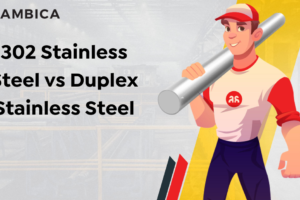The stainless steel industry is creating innovation and employment in all major and minor sectors. Its growth in the present times accounting the increasing applications. Stainless steel is creating a sustainable environment and its extendibility is beyond reach. It is recyclable and hence environmental friendly.
Ongoing development in metallurgy makes it incomparable in the vast availability of metals. The versatility of stainless steel can be defined by the countless accessibility of grades.
The stainless steel family is primarily comprised of austenitic, ferritic, martensitic, duplex, and precipitation hardening stainless steel. These classifications are according to their crystalline structure.
Austenitic stainless steel is the most widely consumed grade worldwide. It has a face-centered cubic crystal structure. Austenitic stainless steel is carbon -chromium stainless steel with the presence of other alloying agents. The higher and lower carbon versions are available for stainless steel grade, which depends upon the application.
300 series are chromium-nickel amalgamations and is most widely used.
Grade 316 is the second common stainless steel next to grade 304. It is of commercial importance. It is characterized by the presence of molybdenum which provides better corrosion resistance to acids.
Grade 316 has different versions available with dual certification to meet specialized criteria.
316 Stainless Steel
Grade 316 is chromium-nickel stainless steel, characterized by the addition of molybdenum, which gives improved corrosion resistance in acidic environments. Specifically, it provides resistance to pitting and crevice corrosion in a chloride environment. It has a higher heat resistance and can be used at elevated temperatures. Grade 316 shows excellent forming ability. It can be easily formed into parts required for applications in various industries like architecture and transportation. Weldability is good for grade 316 and does not require post-weld annealing.
It is the most widely used chemical and food processing equipment, nut and bolts, etc.
316L Stainless Steel
316L is a lower carbon adaptation of grade 316. It is the same as grade 316 except for low carbon content. Low carbon content eliminates carbon carbide precipitation in the temperature range of 800º F to 1500º F. It is commonly used in heavy gauge welded segments.
Grade 316L has more oxidation resistance than 316 in the marine environment. It provides resistance in cryogenic temperature and shows overall better strength.
Grade 316L can be hardened through cold working. It shows good weldability. Post weld annealing is not required.
316Ti Stainless Steel
Grade 316Ti is a stabilized variation of grade 316 stainless steel and is suggested for applications requiring higher temperatures. It is austenitic chromium-nickel stainless steel.
Grade 316 is prone to the formation of carbides at elevated temperatures and can result in intragranular corrosion. Grade 316Ti is characterized by the presence of titanium in small amounts. Its content is around 0.5% in the composition. Titanium stabilizes the micro-structure at high temperatures. It eradicates carbide precipitation and prevents corrosion at elevated temperatures. During the heat treatment, titanium bonds with carbon to form titanium carbide. It prevents the formation of chromium carbides. Hence, 316Ti can be used for a longer duration at higher temperatures.
It also contains molybdenum and provides corrosion resistance in pitting from chloride. 316Ti has similar physical and mechanical properties to grade 316. It features good tensile strength and stress rupture at higher temperatures.
It also shows resistance to acids like sulfuric acids, hydrochloric acid, and sulfates.
Basically, grade 316Ti should be used for the applications required for elevated temperature. 316Ti can be exposed to a higher temperature for a longer duration without the risk of occurrence of precipitation.
Grade 316Ti is commonly used in the oil and gas industry, chemical processes, heat exchangers, marine environments, automation, and paper mill equipment.
Chemical composition
Grade 316 is characterized by the presence of molybdenum with other stainless steel elements.
316L has the same composition as grade 316; only differ by the content of carbon. It is a low carbon version.
316Ti is stabilized titanium grade with the presence of molybdenum and other elements.
| Grade | Carbon | Cr | Ni | Mo | Mn | Si | P | S | Ti | Fe |
| 316 | 0.0-0.07% | 16.5-18.5% | 10-13% | 2.00-2.50% | 0.0-2.00% | 0.0-1.0% | 0.0-0.05% | 0.0-0.02% | – | balance |
| 316L | 0.0-0.03% | 16.5-18.5% | 10-13% | 2.00-2.50% | 0.0-2.0% | 0.0-1.0% | 0.0-0.05% | 0.0-0.02% | – | balance |
| 316Ti | 0.0-0.08% | 16.5-18.5% | 10.5-14% | 2.00-2.50% | 0.0-2.00% | 0.0-1.0% | 0.0-0.05% | 0.0-0.03% | 0.40-0.70% | balance |
Physical properties
Grade 316 attains a metric density of 8.0 g/cm3.
The modulus of elasticity is 193Gpa.
Electrical resistivity is 74 Microhm-cm at 20°C
The melting point is1400°C
Thermal properties
Thermal expansion coefficient is 15.9 µm/m° at 1-100°C and 17.5 µm/m° at 538°C
Thermal conductivity is 16.3 W/mK at 100°C and 21.5 W/mK at 500°C.
Mechanical properties
Grade 316 attains a tensile strength of 500 Mpa and yield strength of 205 Mpa. Hardness is 215 HB maximum. Elongation is 40% in 50mm.
Grade 316L attains a tensile strength of 485 Mpa and yield strength of 170 Mpa. Hardness is 217 HB maximum. Elongation is 40% in 50mm.
Grade 316Ti attains a tensile strength of 515 Mpa and yield strength of 205 Mpa. Elongation is 35% in 50mm.
Magnetic properties
Grade 316, 316L, and 316TI are austenitic stainless steel and non-magnetic in nature.
Heat treatment
Annealing
Grade 316 can be annealed by heating its temperature from 1010-1121°C following by rapid cooling.
Grade 316 cannot be hardened by heat treatment. It can be hardened by cold working. 316 can be formed easily and cold working operations can enhance its strength and hardness.
Corrosion resistance
Grade 316 is designed to provide excellent corrosion resistance in chloride corrosive mediums. It is widely known as marine grade.
Grade 316 stainless steel offers corrosion resistance in freshwater with a high level of chloride. It is famous for providing excellent corrosion resistance in marine environments.
Grade 316L and 316Ti show corrosion resistance equivalent to grade 316 stainless steel.
Heat Resistance
Grade 316 has good oxidation resistance in intermittent service up to 870°C and in continuous mode up to 925°C.
Grade 316L can be exposed to high temperatures as it eliminates carbide precipitation at higher temperatures.
Welding
Welding can be done by the fusion method, with and without fillers. Grade 316 and 316L electrodes are suggested for welding.
Grade 316Ti can be used to weld grade 316 in heavy segments. Post weld treatment may be required for heavy sections.
Machinability
Grade 316 features good machinability.
Machining is easy for Grade 316L as it has low carbon content.
Applications
Grade 316 is extensively used for food processing industry, petrochemical plants, and marine equipments.



